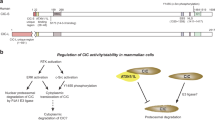Abstract.
Mutations of SALL1 related to spalt of Drosophila have been found to cause Townes-Brocks syndrome, suggesting a function of SALL1 for the development of anus, limbs, ears, and kidneys. No function is yet known for SALL2, another human spalt-like gene. The structure of SALL2 is different from SALL1 and all other vertebrate spalt-like genes described in mouse, Xenopus, and Medaka, suggesting that SALL2-like genes might also exist in other vertebrates. Consistent with this hypothesis, we isolated and characterized a SALL2 homologous mouse gene, Msal-2. In contrast to other vertebrate spalt-like genes both SALL2 and Msal-2 encode only three double zinc finger domains, the most carboxyterminal of which only distantly resembles spalt-like zinc fingers. The evolutionary conservation of SALL2/Msal-2 suggests that two lines of sal-like genes with presumably different functions arose from an early evolutionary duplication of a common ancestor gene. Msal-2 is expressed throughout embryonic development but also in adult tissues, predominantly in brain. However, the function of SALL2/Msal-2 still needs to be determined.
Similar content being viewed by others
Author information
Authors and Affiliations
Additional information
Received: 1 June 1999 / Accepted: 26 August 1999
Rights and permissions
About this article
Cite this article
Kohlhase, J., Altmann, M., Archangelo, L. et al. Genomic cloning, chromosomal mapping, and expression analysis of Msal-2 . Incorporating Mouse Genome 11, 64–68 (2000). https://doi.org/10.1007/s003350010012
Published:
Issue Date:
DOI: https://doi.org/10.1007/s003350010012




